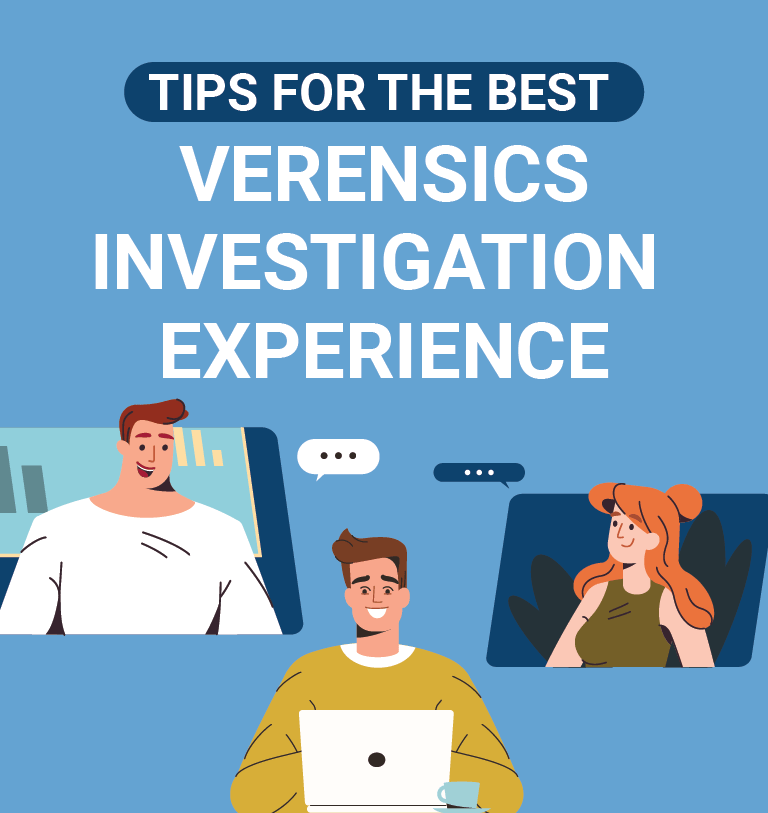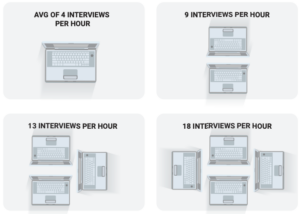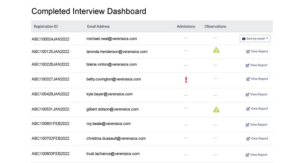Frequently Asked Questions
Want to know more about Verensics?
You’ve come to the right place.

Pre-Employment FAQs
We recommend using the platform as early as possible in your process. That assures you will collect the most meaningful information with minimum time and effort. Use this information to have a more efficient and focused job interview.
We offer three types of interviews:
- Pre-employment
- Insider Threat programs and Code of Conduct
- Workplace investigative interviews
Our online interview is a smart questionnaire powered by AI to mimic a face-to-face interview with an industrial psychologist, or in some cases, a corporate investigator.
We gather the most reliable information about a person’s past criminal activity and habits, regardless of whether the activity was ever reported for prosecution.
Tests and assessments provide a score that reflects a specific element they are designed to measure. These scores are derived from the performance of a group of people who have taken the same test. This means that the score is based on how closely the individual’s performance matches the performance of the group. In other words, a high score suggests that a person’s performance is similar to what most people in the group achieved.
However, it’s important to note that these test results, while useful, may not be as accurate as a face-to-face interview in certain situations. This is because tests can’t capture the full complexity of an individual’s personality or abilities. In an interview, a trained person can ask follow-up questions and get a better understanding of a person’s unique qualities and characteristics, which tests might not fully capture. Therefore, while tests and assessments can provide valuable insights, they are not always the most comprehensive way to understand a person.
While tests and assessments can offer valuable information, they have limitations, and a face-to-face interview can provide a more holistic understanding of an individual. Verensics reports more closely align with the findings from a face to face interview. The information presented on the Verensics report allows you to get to know the character of the person you are interviewing, and if they share the same level of ethics that you and your organization have, in the most professional, unbiased, and time-efficient way.
If you and your team would like to experience the interview, please keep
these tips in mind.
Each of our interviews is designed and planned from an algorithmic, logical, and scientific perspective to reflect the specific stage and situation of the person being interviewed:
Pre-employment interviews are designed for candidates only
Insider Threat and Code of Conduct interviews are designed for current employees
Workplace investigative interviews are designed for employees who are part of an investigation
To successfully measure trends and metrics, we recommend you make sure your organization’s information is set up correctly. Make sure you enter all relevant data, like hiring decisions. These practices will help you track ROI.
Our interviews cover a variety of topics, which are heavily researched and found to be the most counterproductive workplace behaviors. Some topics will be more meaningful to you than others. We recommend you focus on findings important to you.
The most meaningful finding is an admission of past criminal behavior or habits. Whether there are many findings or none, these help you understand a person’s true character. Admissions are where you need to spend most of your time interviewing. An admission is when an interviewee answers that they were involved in misconduct or criminal activity.
Usually, you can treat findings in the green and yellow as “good to know.” They don’t always require follow up unless a specific question piques your interest.
A good path for general follow up is asking questions like:
“How was the interview?”
“Do you think the answers you provided reflect you well?”
Diving into a specific question you can simply reframe the question.
For example:
“You mentioned on your interview that you were fired for hitting a coworker. Can you tell me more about that?”
Presents how often a person contradicted themselves during the interview.
Green is very consistent
Yellow is somewhat consistent
Red is inconsistent
Investigations FAQs
To expedite your processes of collecting relevant intelligence by communicating with as many employees as needed, at the same time, with no geographical limitations.
As early as possible in your investigative process. That assures you will collect the most meaningful information with minimum time and effort. Use it to interview all relevant personnel, including suspects and employees who have knowledge of the incident. Then, based on the findings, schedule conversations to confirm admissions and observations.
Improve employee experience
Reports generated immediately
Save travel expenses
Eliminate the need for HR/Legal witness
React faster to incidents
Lower shrinkage threshold for investigations
Stop triaging cases
After your account is active, there are just a few things to make sure you have in place:
Confirm your IT team “whitelists” www.verensics.com and app.verensics.com
Make sure your interviewees have privacy while completing the online interview
We recommend you follow these guidelines.
Choose the most relevant categories for the case, for example
If your case is about employee Theft, we recommend the categories:
Discount/Credit Fraud
Employee Theft > Emphasized
Honesty/Integrity
Interview Preparation
Reporting Inventory



